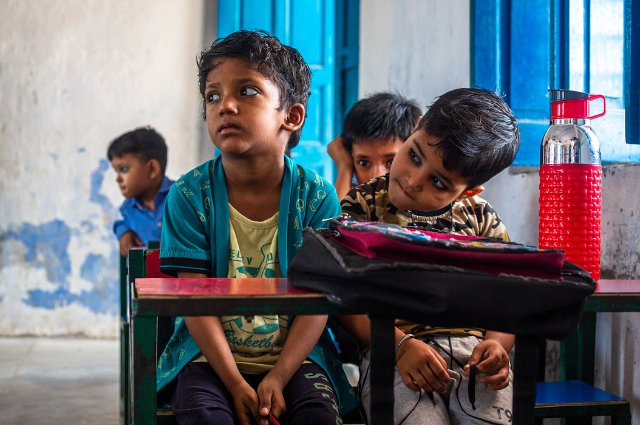
Photo by Church of the King on Unsplash
Education, the compass that guides Indian society through the uncharted territories of understanding, underwent a profound recalibration with the advent of the National Education Policy (NEP) 2020- a dynamic blueprint that aimed to shift education from a memory marathon to an ecosystem of creativity, adaptability, and holistic learning.
Philosophical Roots:
At its essence, the NEP channels the philosophy of John Dewey, a pioneering educational reformer who believed that education isn't just preparation for life; it is life itself. It treats education as an intrinsic part of life, emphasising experiential learning and active engagement with ideas. The NEP approaches education practically and holistically and invites students to dance with ideas, all the while emphasising the power of multilingualism to connect not just with minds but with hearts as well.
In the words of Nelson Mandela, "if you talk to a man in a language he understands, that goes to his head. If you talk to him in his language, that goes to his heart."
Structural Evolution:
Imagine a seismic shift in education, where the 5+3+3+4 model heralds a new dawn, acknowledging the unique developmental stages of learners and guiding them accordingly from the age of three to eighteen. Imagine a departure from the traditional science and arts stream division by the introduction of a flexible approach that allows students to choose subjects across disciplines.
At its core, the NEP 2020 is structured around these two advents. It,
- Calls for the recognition of distinct developmental stages in students and the subsequent tailoring of education to individual needs.
- Aims to dismantle rigid subject silos and encourages a seamless integration of diverse disciplines, thereby promoting a multidisciplinary and holistic education that encourages learners to explore diverse interests and combine science, arts, and vocational courses based on their aptitude and passion.
Empowering Educators:
"The influence of teachers extends beyond the classroom, well into the future." - F. Sionil Jose
In the NEP, educators are positioned as torchbearers. The emphasis on teacher empowerment goes beyond routine training. It recognizes that effective teaching is not merely about imparting knowledge but involves a continuous process of refining skills, embracing innovative methodologies, and staying abreast of evolving educational practices. By prioritising teacher empowerment, the NEP seeks to elevate the quality of education by investing in the ongoing development and professional growth of educators.
Real-world Cadence
Beyond classrooms and textbooks, the policy introduces a pragmatic rhythm that resonates with the real world. It acknowledges education not as a detached theory, but as the heartbeat of society and emphasises its integral role in shaping and harmonising the dynamics of the real world. This approach reflects an understanding that education is not solely an academic pursuit but a force that permeates every aspect of society, influencing its pulse and contributing to the practical, real-world harmony of diverse communities and cultures.
Challenges On The Stage

Image by Swastik Arora from Pixabay
Recent incidents highlight vulnerabilities in the NEP 2020, underscoring a challenge where educational institutions sidestep government compliances to obtain permits and infrastructure and socioeconomic disparities cast a shadow on the aspirations of students.
Addressing these challenges is crucial for realising the full potential of NEP 2020 and ensuring that it transforms the educational landscape in a way that benefits all students.
Proposals for strengthening the Policy:
- Renewal of Educational Licences: Institutions should undergo licence renewal every three years. This interval would allow for dynamic assessments, ensuring that institutions adhere to safety and quality standards, as outlined by the concerned authorities.
- Online Grievance Platform: In this digital era, the NEP should meet the need for an online platform where students can voice their concerns. This virtual podium would empower students, providing a direct channel to address issues related to the quality of education, safety, and other grievances.
- Equitable Resource Allocation: Implementation of a system for equitable distribution of educational resources, ensuring that schools, especially in economically disadvantaged areas, have access to quality infrastructure, teaching materials, and technology.
- Socioeconomic Inclusion Programs: Development of targeted programs to address socioeconomic disparities, providing financial support, scholarships, and mentorship initiatives to students from underprivileged backgrounds, and thereby fostering equal opportunities for learning.
- Teacher Training and Support Initiatives: Establishment of comprehensive training programs for teachers, particularly in regions facing socioeconomic challenges, to ensure they are well-equipped to implement the innovative aspects of NEP and provide support where needed.
- Public-Private Partnerships for Infrastructure: Facilitation of collaborations between public and private sectors to improve educational infrastructure, especially in economically weaker regions. This partnership would help bridge gaps and enhance facilities for a more inclusive learning environment.
- Digital Inclusion Initiatives: Implementation of initiatives to bridge the digital divide, ensuring that students from all backgrounds have access to online resources and technology. This can involve subsidised internet programs, providing devices, and creating digital literacy programs.
- Flexible Funding Models: Exploration and implementation of funding models that take into account the specific needs and challenges of schools in diverse socioeconomic settings, promoting financial inclusivity in education.
Conclusion
In concluding the discussion on NEP 2020, it's crucial to perceive it not as a static document but as an evolving narrative. In this dynamic narrative, each student assumes the role of a protagonist, navigating through the stages of education. Every teacher becomes a guide, steering the storyline by imparting knowledge and shaping the characters of the learners. Each educational institution serves as a stage, the setting for the dramatic unfolding of this educational narrative.
Just like a compelling drama, NEP 2020 envisions a plot where students actively engage with diverse subjects, teachers play pivotal roles in nurturing intellectual growth, and institutions provide the backdrop for a holistic and transformative learning experience. This dynamic narrative acknowledges the evolving nature of education, emphasising adaptability, creativity, and inclusivity as essential elements in the ongoing script of learning and development.
